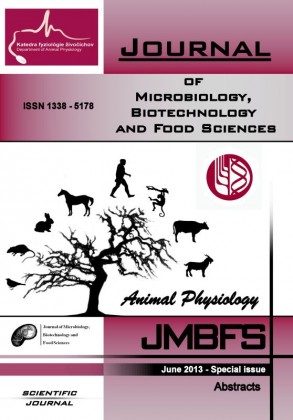THE USE OF ELECTROPHORESIS IN LABORATORY DIAGNOSTIC OF SERUM PROTEINS IN VETERINARY MEDICINE
Keywords:
serum proteins, electrophoresis, albumin, globulin, animalsAbstract
In this study, we explain the need for more detailed laboratory diagnostic of serum proteins in veterinary medicine. The application of proteomic approaches over the last decade has provided new tools for clarifying the molecular aspects of physiological states, and for understanding the etiology and pathogenesis of many diseases. Proteomics performs large-scale protein analysis, describes the entire protein complement of a cell, tissue, biological fluid or organism and provides information on protein expression, localization, functions and interactions.Majority of plasmatic proteins is synthesized in hepatocytes, with albumin representing their largest quantitative part. The second major contributor is the imune system. Plasma proteins perform a nutritive function, exert colloidal osmotic pressure, and aid in the maintenance of acid-base balance. Individual proteins serve as enzymes, antibodies, coagulation factors, hormones, and transport substances. Fresh serum contains all of the plasma proteins except fibrinogen, factor V, and factor VIII. These are consumed during clot formation.
The electrophoretic technique is the current standard of reference for the fractionation of the serum proteins in clinical biochemistry. Serum proteins determined by electrophoresis involves albumin, α1, α2, β1, β2 and γ-globulins. Individual blood serum proteins have different functions and their identification is used also as a diagnostic tool. Many of these proteins are the so-called acute phase proteins. For example, α1-acid glycoprotein concentration increases during inflammation or infection, as well as concentrations of other acute phase proteins (CRP, serum amyloid A protein, α1-antitrypsin, haptoglobin, ceruloplasmin and fibrinogen) based on increased synthesis of hepatocytes with subsequent release of these proteins in blood. Alfa1-antitrypsin, member of the superfamily of proteinase inhibitors, has a crucial effect on inactivation of neutrophil elastase and other proteases, which maintains protease–antiprotease balance. Ceruloplasmin takes part in copper metabolism and its decreased plasmatic concentration is associated with copper deficiency. Concentrations of serum proteins are influenced by many physiological (age, pregnancy, lactacion etc.) and pathological (malnutrition, renal and hepatal diseases etc.) factors. Current widespread use of electrophoresis is commensurate with its reflection of a variety of changes in serum protein patterns in disease in different species of animals.
Downloads
Download data is not yet available.
Downloads
Published
2013-06-06
How to Cite
Nagyová, V., Tóthová, C., Å oltésová, H., Vargová, M., & Nagy, O. (2013). THE USE OF ELECTROPHORESIS IN LABORATORY DIAGNOSTIC OF SERUM PROTEINS IN VETERINARY MEDICINE. Journal of Microbiology, Biotechnology and Food Sciences, 2(Abstracts special issue), 6–7. Retrieved from https://office2.jmbfs.org/index.php/JMBFS/article/view/7521
Issue
Section
Biotechnology
License
Copyright (c) 2013 Veronika Nagyová, Csila Tóthová, Helena Šoltésová, Mária Vargová, Oskar Nagy

This work is licensed under a Creative Commons Attribution 4.0 International License.
All papers published in the Journal of Microbiology, Biotechnology and Food Sciences are published under a CC-BY licence (CC-BY 4.0). Published materials can be shared (copy and redistribute the material in any medium or format) and adapted (remix, transform, and build upon the material for any purpose, even commercially) with specifying the author(s).

